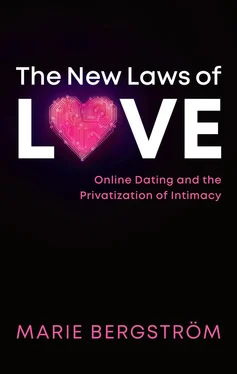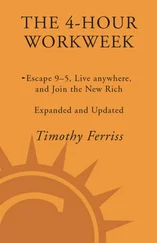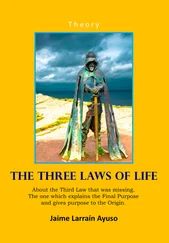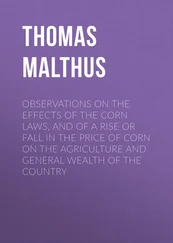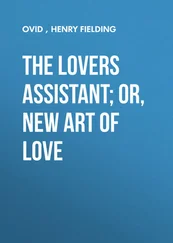Library of Congress Control Number: 2021939855
by Fakenham Prepress Solutions, Fakenham, Norfolk NR21 8NL
The publisher has used its best endeavours to ensure that the URLs for external websites referred to in this book are correct and active at the time of going to press. However, the publisher has no responsibility for the websites and can make no guarantee that a site will remain live or that the content is or will remain appropriate.
Every effort has been made to trace all copyright holders, but if any have been overlooked the publisher will be pleased to include any necessary credits in any subsequent reprint or edition.
For further information on Polity, visit our website: politybooks.com
A great many people have contributed to this book in different ways.
I would first like to thank all the persons interviewed for this research who shared their experiences of online dating but to whom I cannot refer individually. I am truly grateful to Meetic Group for our cooperation, which allowed me to take an original and international approach to user behavior. Special thanks to Héloïse de Monstiers, Stéphane-Laure Bernelin, and Hélène Point for their trust and encouragements.
A big thank you to John Thompson at Polity, who made this publication possible and provided me with valuable advice, and to Wanda Romanowski, Eva Lelièvre, and Alain Blum at INED Éditions for their incredible support. Thanks also to Michel Bozon, who has played an important role in this research as my advisor, and to Eva Illouz for encouraging me to publish this book and helping me to do so. I was delighted to work with Bernard Cohen, who translated several chapters of this book, and Rébecca Lévy-Guillain, who conducted interviews for this project.
I am indebted to all the people who have commented on various chapters of this book, first of all Étienne Ollion, who helped me improve the text in a decisive way. Thanks also to the anonymous reviewers at Polity and at INED Éditions, as well as to Florence Maillochon, Jan Bergström, and Louise Caron. I received valuable feedback on previous versions of this text by Annabelle Allouch, Milan Bouchet-Valat, Thomas Collas, Joseph Confavreux, Thomas Depecker, Claire-Lise Gaillard, Josué Gimel, Gwenaëlle Mainsant, Elise Marsicano, Camille Masclet, Marie Plessz, Clément Rivière, Mathieu Trachman, and Florian Vörös: I wish to thank all of you. My gratitude goes also to Arnaud Régnier-Loilier and Wilfried Rault, who introduced me to the EPIC survey team.
Finally, I would like to thank the institutions who funded this research: the French Institute for Demographic Studies (INED), the GIS Institut du Genre, the Oxford-Sciences Po Programme (OxPo), and the Observatoire sociologique du changement (OSC) at SciencesPo Paris.
I feel incredibly fortunate with my loving and supportive family. After years of publishing in French, I am delighted to be able to share my research with those to whom I owe so much. This book is dedicated to Ulla, Hans, Jan, Linda, Ebba and Oskar Bergström.
1.1.Front page of The Matrimonial News and Special Advertiser (February 1877)
1.2.Newspaper publicity for the “computer dating” agency Compatibility ( LIFE , August 1969)
1.3.Interface of the BBS Matchmaker
1.4.Interface of the Minitel messaging system ULLA
1.5.Interface of Match.com(year 2000)
1.6.Interface of Tinder (year 2012)
2.1. Homogeneity in dating app interfaces: from left to right, Tinder, Bumble, Hinge, happn, and Facebook Dating
2.2. Stereotypical branding between love and sex (Match and EasyFlirt)
3.1. Rate of use of online dating platforms in France, the United States, and Germany (%)
3.2. Ranking of meeting venues in the United States in 2019 and in Germany in 2020 (%)
4.1. Time between initial contact and first sexual intercourse among couples in France (%)
6.1. Percentage, by age group, of the women and men in the United States who have used a dating site or app at least once
6.2. Pyramid of ages, by gender, declared on four European dating platforms (%)
7.1. Share of female and male users initiating contact on dating platforms in six countries in 2019 (%)
| ATP |
The American Trends Panel wave 56, Pew Research Center, Washington, DC, 2019 (4,860 respondents). For more information, see Pew Research Center, 2020a, 2020b, 2020c. |
| Baromètre 2016 |
Baromètre Santé 2016, Santé publique France, 2016 (15,216 respondents). For more information, see Bajos et al., 2018. |
| CSF |
Contexte de la sexualité en France, INSERM–INED, 2006 (12,364 respondents). For more information, see Bajos and Bozon, 2012. |
| EPIC |
Étude des parcours individuels et conjugaux, INED–INSEE, 2013–2014 (7,825 respondents). For more information, see Rault and Régnier-Loilier, 2019. |
| Eurostat |
Eurostat database, 2002–2019, European Union. For more information, see Eurostat, 2020. |
| GSS |
General Social Survey, NORC–University of Chicago–National Science Foundation, 1972–2018 (64,814 respondents). For more information, see Marsden, 2012. |
| IALP |
Internet & American Life Project Survey, Pew Research Center, Washington, DC, 2013 (2,252 respondents). For more information, see Smith and Duggan, 2013. |
| Pairfam |
The German Family Panel release 12.0, German Research Foundation (DFG), 2019–2020 (7,630 respondents). For more information, see Huinink et al., 2011; Brüderl et al., 2021. |
| PTS |
Pew Tracking Survey, Pew Research Center, Washington, DC, 2015 (2,001 respondents). For more information, see Pew Research Center, 2016. |
Meetic Group Platforms, Meetic Group Europe, 2019:
Platforms analyzed: Match, Meetic, Ourtime, DatingDirect, Lexa, LoveScout24 and Neu.
Metadata on: anonymized user profiles (27,709,707 profiles) and contact behavior (824,989,940 exchanged messages).
Interviews with users, 2007–2018:
biographical interviews with 82 French users of dating sites and applications, conducted by Marie Bergström and Rébecca Lévy-Guillain.
Interviews with entrepreneurs, 2009–2019:
semi-structured interviews with 19 French, US, and Canadian founders or employees of dating sites and applications, conducted by Marie Bergström.
Match, Meetic, OkCupid, Grindr, LoveScout, Tinder, Happn, Bumble… These are just a few of the thousands of dating platforms available online today. The first website to specialize in matchmaking appeared in the United States in the mid-1990s and was soon to be imitated. As the internet expanded internationally, competing sites rolled out at a quick pace across North America and Europe. They were joined some twenty years later by mobile phone applications that immediately became immensely popular, especially among the young. In the past two decades, these platforms have remapped the landscape of dating across much of the western world and beyond, changing the way people meet partners, but also challenging our ideas about sex and love.
The change is remarkable. Since at least the nineteenth century, personal ads, marriage brokers, and other “lonely hearts” networks have offered their services to bring single people together and match prospective partners. Today’s dating sites and apps are the direct descendants of those earlier forms of mediated dating; in fact they have inherited many features from their ancestors. What is fundamentally new, however, is their popularity. Until the advent of the internet, the use of commercial matchmaking remained a marginal and marginalized practice. In the 1980s and 1990s, surveys carried out in the United States and in France showed that approximately fewer than 1 in 100 people had met their spouse through a matrimonial ad or agency, for example (Bozon and Heran, 1989; Laumann et al., 1994). In the ranks of the heterosexual population, to resort to such services was taboo; the companies were generally distrusted and users consisted predominantly of divorced and widowed individuals. Mediated dating was considered something of an outcast behavior in the world of dating.
Читать дальше
